Abstract
AIM--To validate the use of a new mouse monoclonal antibody (1D5) directed against the N-terminal domain (A/B region) of the oestrogen receptor in an immunohistochemical assay (ER-IHA) for paraffin wax embedded tissue. METHODS--Breast cancer specimens were surgically obtained from 119 previously untreated patients. For comparison, oestrogen receptor was measured from cytosol fractions using an established oestrogen receptor enzyme immunoassay (ER-EIA) method. Oestrogen receptor "H-scores" were obtained from the ER-IHA after antigen retrieval using microwave treatment. Where discrepancies occurred between the two methods, further immunohistochemistry was performed using the H222 antibody from the Abbott Laboratories ER-ICA kit. RESULTS--The correlation between the two methods was non- linear, but despite this there was an 86% concordance between ER-EIA and ER-IHA using the 1D5 ER antibody. Fifty four per cent of tumours (64/119) were oestrogen receptor positive and 32% (38/119) were negative by both assays. A mismatch between the ER-EIA and ER-IHA occurred in 17 cases. Seven tumours were IHA positive but EIA+, but five of these were borderline negative by EIA, having values of > 5 and < 10 fmol/mg protein. Ten tumours were IHA negative and EIA+; four of these tumours were completely negative by IHA in the section studied. A further IHA assay, carried out on the 17 tumour mismatches with H222 antibody, showed that three tumours remained substantially discordant. These three tumours were strongly positive with the 1D5 antibody and negative with the H222 antibody. Two of these discordant tumours were of the rare ER negative and PgR positive phenotype and may contain oestrogen receptor that is of biological interest but which lacks the hormone binding epitope. CONCLUSIONS--The concordance between the classic enzyme immunoassay technique and the new immunohistochemical method on paraffin wax embedded sections was good. Moreover, the IHA technique using the 1D5 antibody against the N-terminal was easily reproducible. This technique may allow oestrogen receptor content to be determined in large cohorts of patients in whom archival tumour material is available.
Full text
PDF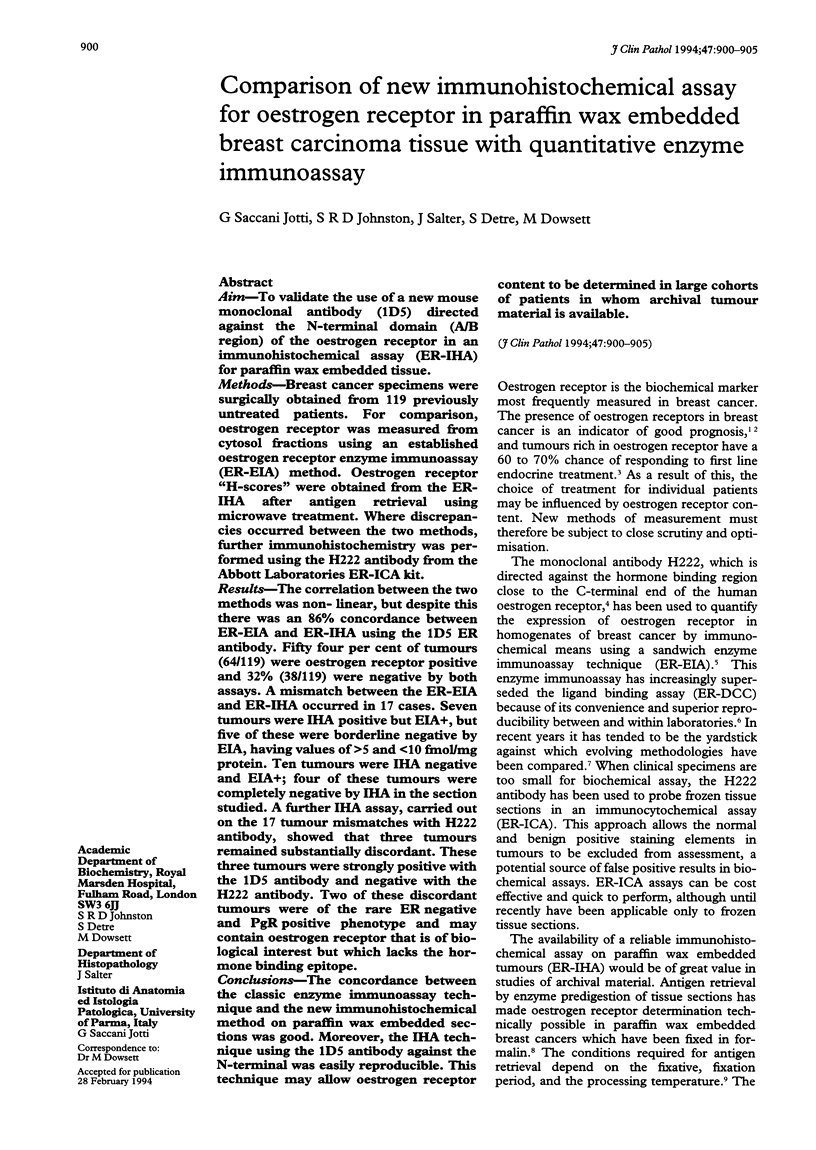
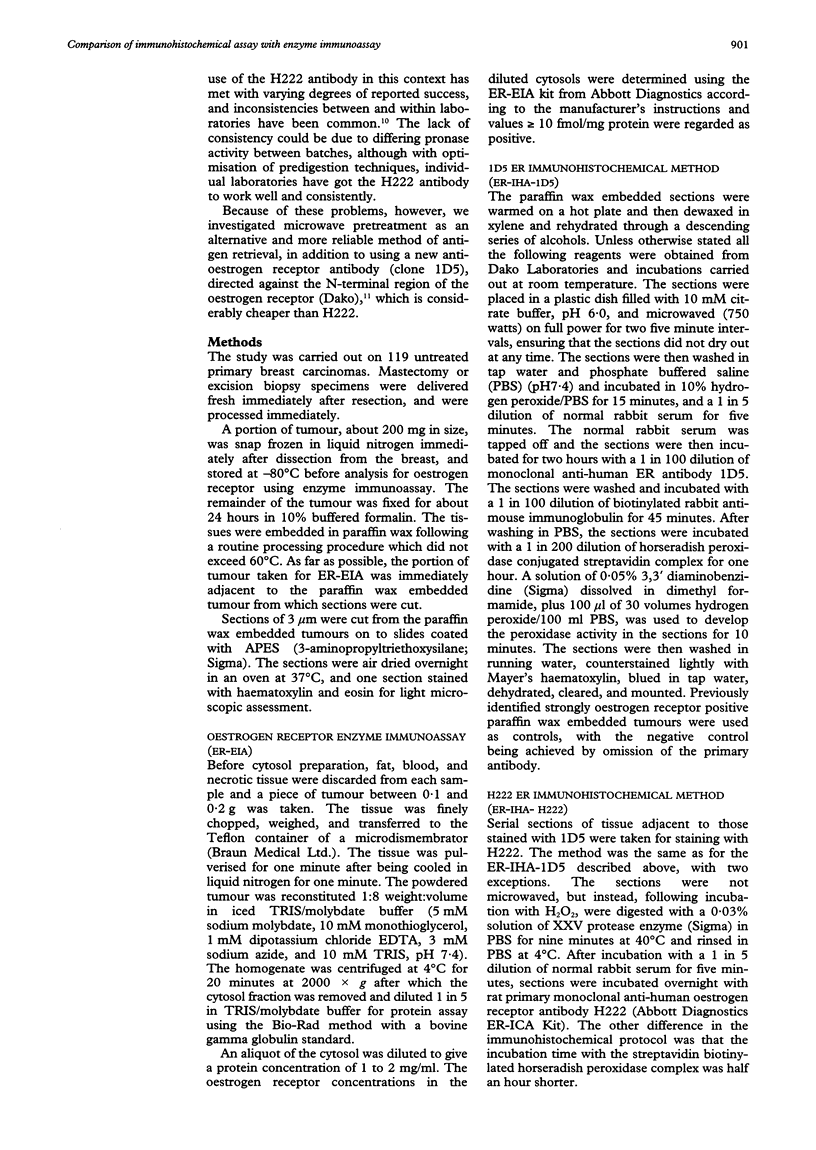
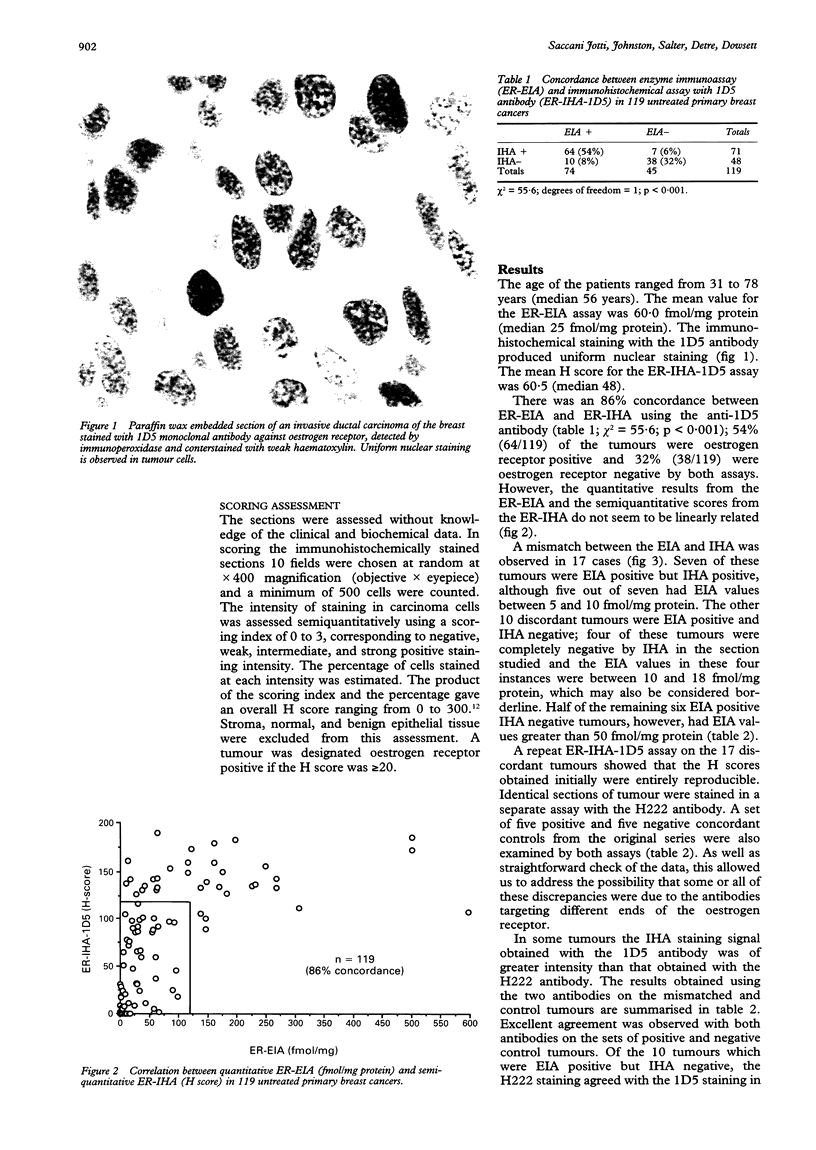
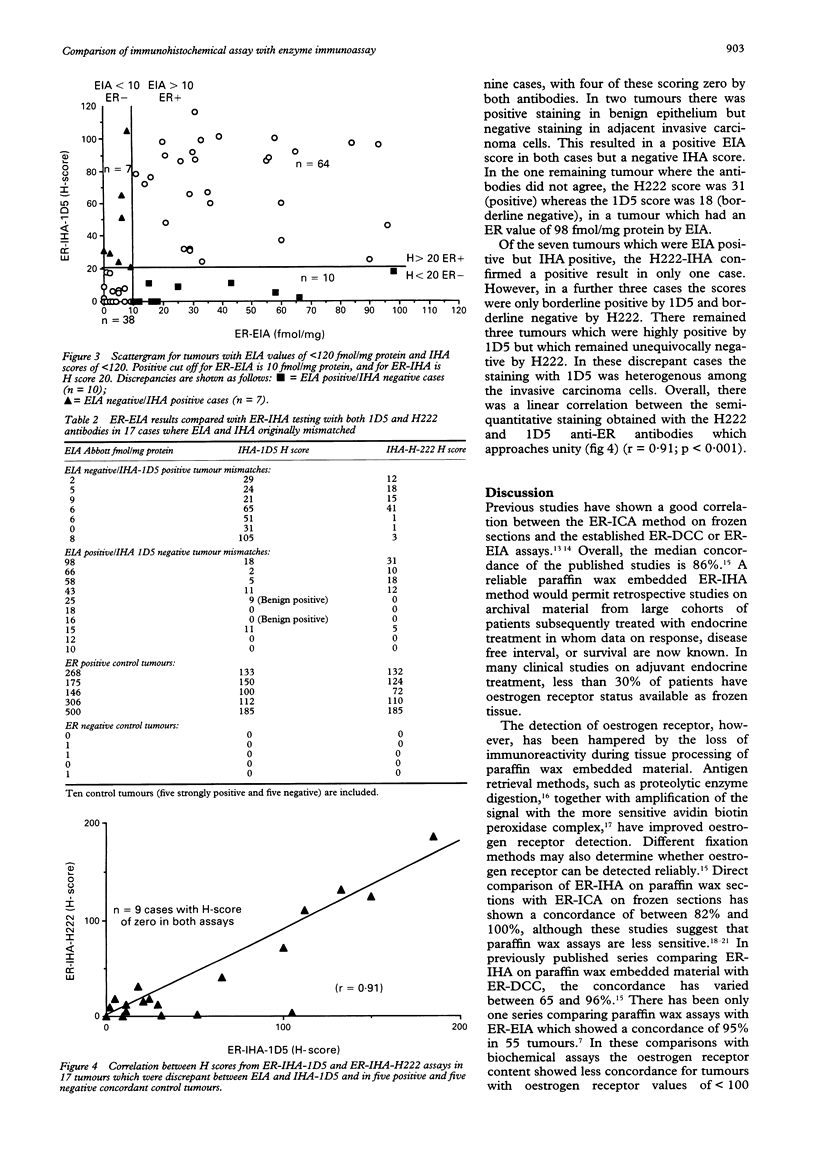
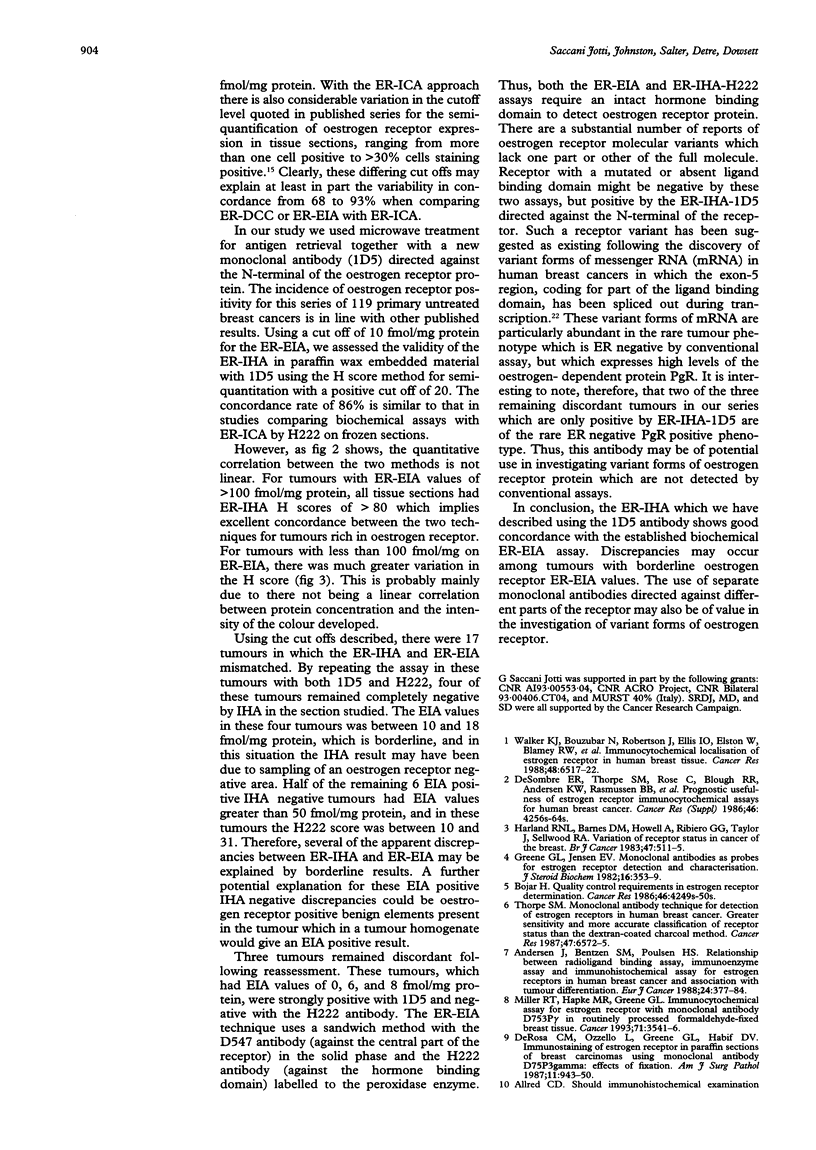

Images in this article
Selected References
These references are in PubMed. This may not be the complete list of references from this article.
- Allred D. C. Should immunohistochemical examination replace biochemical hormone receptor assays in breast cancer? Am J Clin Pathol. 1993 Jan;99(1):1–3. doi: 10.1093/ajcp/99.1.1. [DOI] [PubMed] [Google Scholar]
- Andersen J., Bentzen S. M., Poulsen H. S. Relationship between radioligand binding assay, immunoenzyme assay and immunohistochemical assay for estrogen receptors in human breast cancer and association with tumor differentiation. Eur J Cancer Clin Oncol. 1988 Mar;24(3):377–384. doi: 10.1016/s0277-5379(98)90006-2. [DOI] [PubMed] [Google Scholar]
- Andersen J. Determination of estrogen receptors in paraffin-embedded tissue. Techniques and the value in breast cancer treatment. Acta Oncol. 1992;31(6):611–627. doi: 10.3109/02841869209083843. [DOI] [PubMed] [Google Scholar]
- Andersen J., Orntoft T. F., Poulsen H. S. Immunohistochemical demonstration of estrogen receptors (ER) in formalin-fixed, paraffin-embedded human breast cancer tissue by use of a monoclonal antibody to ER. J Histochem Cytochem. 1988 Dec;36(12):1553–1560. doi: 10.1177/36.12.2461414. [DOI] [PubMed] [Google Scholar]
- Andersen J., Thorpe S. M., King W. J., Rose C., Christensen I., Rasmussen B. B., Poulsen H. S. The prognostic value of immunohistochemical estrogen receptor analysis in paraffin-embedded and frozen sections versus that of steroid-binding assays. Eur J Cancer. 1990 Apr;26(4):442–449. doi: 10.1016/0277-5379(90)90013-j. [DOI] [PubMed] [Google Scholar]
- Curran R. C., Gregory J. The unmasking of antigens in paraffin sections of tissue by trypsin. Experientia. 1977 Oct 15;33(10):1400–1401. doi: 10.1007/BF01920206. [DOI] [PubMed] [Google Scholar]
- De Rosa C. M., Ozzello L., Greene G. L., Habif D. V. Immunostaining of estrogen receptor in paraffin sections of breast carcinomas using monoclonal antibody D75P3 gamma: effects of fixation. Am J Surg Pathol. 1987 Dec;11(12):943–950. doi: 10.1097/00000478-198712000-00004. [DOI] [PubMed] [Google Scholar]
- Fuqua S. A., Fitzgerald S. D., Chamness G. C., Tandon A. K., McDonnell D. P., Nawaz Z., O'Malley B. W., McGuire W. L. Variant human breast tumor estrogen receptor with constitutive transcriptional activity. Cancer Res. 1991 Jan 1;51(1):105–109. [PubMed] [Google Scholar]
- Greene G. L., Jensen E. V. Monoclonal antibodies as probes for estrogen receptor detection and characterization. J Steroid Biochem. 1982 Mar;16(3):353–359. doi: 10.1016/0022-4731(82)90045-0. [DOI] [PubMed] [Google Scholar]
- Hanna W., Mobbs B. G. Comparative evaluation of ER-ICA and enzyme immunoassay for the quantitation of estrogen receptors in breast cancer. Am J Clin Pathol. 1989 Feb;91(2):182–186. doi: 10.1093/ajcp/91.2.182. [DOI] [PubMed] [Google Scholar]
- Harland R. N., Barnes D. M., Howell A., Ribeiro G. G., Taylor J., Sellwood R. A. Variation of receptor status in cancer of the breast. Br J Cancer. 1983 Apr;47(4):511–515. doi: 10.1038/bjc.1983.81. [DOI] [PMC free article] [PubMed] [Google Scholar]
- Hiort O., Kwan P. W., DeLellis R. A. Immunohistochemistry of estrogen receptor protein in paraffin sections. Effects of enzymatic pretreatment and cobalt chloride intensification. Am J Clin Pathol. 1988 Nov;90(5):559–563. doi: 10.1093/ajcp/90.5.559. [DOI] [PubMed] [Google Scholar]
- Hsu S. M., Raine L., Fanger H. Use of avidin-biotin-peroxidase complex (ABC) in immunoperoxidase techniques: a comparison between ABC and unlabeled antibody (PAP) procedures. J Histochem Cytochem. 1981 Apr;29(4):577–580. doi: 10.1177/29.4.6166661. [DOI] [PubMed] [Google Scholar]
- Miller R. T., Hapke M. R., Greene G. L. Immunocytochemical assay for estrogen receptor with monoclonal antibody D753P gamma in routinely processed formaldehyde-fixed breast tissue. Comparison with frozen section assay and with monoclonal antibody H222. Cancer. 1993 Jun 1;71(11):3541–3546. doi: 10.1002/1097-0142(19930601)71:11<3541::aid-cncr2820711113>3.0.co;2-x. [DOI] [PubMed] [Google Scholar]
- Shimada A., Kimura S., Abe K., Nagasaki K., Adachi I., Yamaguchi K., Suzuki M., Nakajima T., Miller L. S. Immunocytochemical staining of estrogen receptor in paraffin sections of human breast cancer by use of monoclonal antibody: comparison with that in frozen sections. Proc Natl Acad Sci U S A. 1985 Jul;82(14):4803–4807. doi: 10.1073/pnas.82.14.4803. [DOI] [PMC free article] [PubMed] [Google Scholar]
- Shintaku I. P., Said J. W. Detection of estrogen receptors with monoclonal antibodies in routinely processed formalin-fixed paraffin sections of breast carcinoma. Use of DNase pretreatment to enhance sensitivity of the reaction. Am J Clin Pathol. 1987 Feb;87(2):161–167. doi: 10.1093/ajcp/87.2.161. [DOI] [PubMed] [Google Scholar]
- Thorpe S. M. Monoclonal antibody technique for detection of estrogen receptors in human breast cancer: greater sensitivity and more accurate classification of receptor status than the dextran-coated charcoal method. Cancer Res. 1987 Dec 15;47(24 Pt 1):6572–6575. [PubMed] [Google Scholar]
- Walker K. J., Bouzubar N., Robertson J., Ellis I. O., Elston C. W., Blamey R. W., Wilson D. W., Griffiths K., Nicholson R. I. Immunocytochemical localization of estrogen receptor in human breast tissue. Cancer Res. 1988 Nov 15;48(22):6517–6522. [PubMed] [Google Scholar]
- al Saati T., Clamens S., Cohen-Knafo E., Faye J. C., Prats H., Coindre J. M., Wafflart J., Caverivière P., Bayard F., Delsol G. Production of monoclonal antibodies to human estrogen-receptor protein (ER) using recombinant ER (RER). Int J Cancer. 1993 Oct 21;55(4):651–654. doi: 10.1002/ijc.2910550423. [DOI] [PubMed] [Google Scholar]



